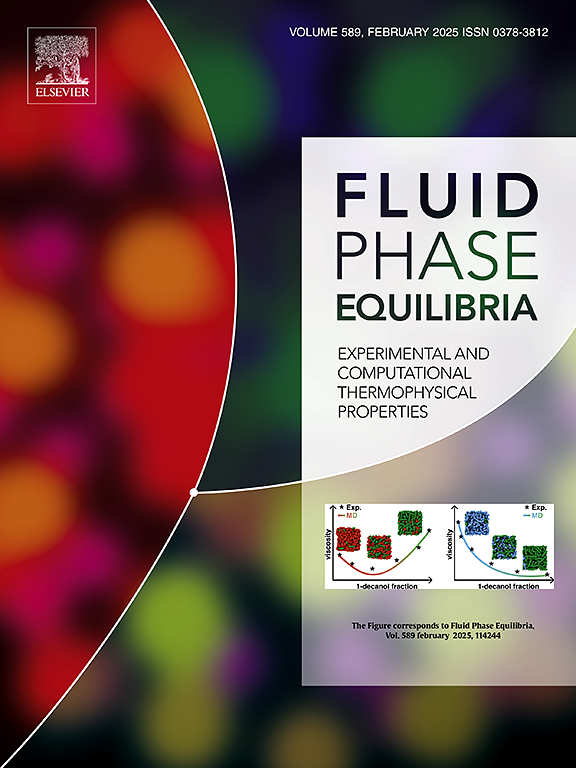让我们重新考虑三次状态方程的高级混合规则
IF 2.7
3区 工程技术
Q3 CHEMISTRY, PHYSICAL
引用次数: 0
摘要
使用范德华混合状态方程最具挑战性的一个方面是确定该方程中涉及的系数a(吸引参数)和b(协体积)的适当表达式。自Huron和Vidal首次提出“EoS/gE”高级混合规则以来,已经过去了45年。通过将在无限参考压力下,由状态方程导出的多余吉布斯能量的数学表达式gE,与由显式活度系数模型导出的相同量相等,他们推导出了比值a/b的表达式。在Huron和Vidal提出最初建议的十年后,Michelsen在最初建议的基础上推导出了“零参考压力”(ZRP)方法,并提出了近似的ZRP混合规则MHV1和MHV2。在整个20世纪90年代和21世纪初,休伦-维达尔和ZRP方法经常经历多次修改,以弥补一些明显的缺点。似乎围绕高级混合规则的争论现在已经结束,本世纪头十年提出的最新结论在一定程度上得到了共识。本文的目的是根据我们最近对三次状态方程的高级混合规则的研究所获得的科学见解,重新展开辩论。通过将状态方程中表示的多余吉布斯能量与活度系数模型中表示的相同量相等来推导混合规则的概念(这种等式称为“匹配方程”)无疑是一个吸引人的概念。然而,经验表明,这种匹配方程并非没有其局限性,特别是由于缺乏足够的约束。我们已经得出结论,得出没有缺点的高级混合规则的唯一方法是确保不仅从状态方程和活度系数模型中得到gE的完整表达式相等,而且组成它的三个单独的贡献(即组合、残余和压力与多余体积P·vE的乘积)相等。正如本文所讨论的,实现这一目标是具有挑战性的,我们得出结论,开发安全混合规则的最佳和唯一解决方案是修改由休伦-维达尔和迈克尔森提出的匹配方程,只等于剩余贡献。基于这一观察,我们展示了ZRP和HV混合规则的演示如何被重新设计,以达到一个独特的和通用的(独立于参考压力)混合规则,称为UHVM(统一休伦比达尔迈克尔森)混合规则。我们希望这一结果能激发人们对三次方程混合规则的新思考。本文章由计算机程序翻译,如有差异,请以英文原文为准。
Let us rethink advanced mixing rules for cubic equations of state
One of the most challenging aspects of using a Van der Waals type equation of state for mixtures is determining the appropriate expressions for the coefficients (attractive parameter) and (covolume) involved in this equation. It has been 45 years since Huron and Vidal first proposed the “EoS/” advanced mixing rules. By equating under infinite reference pressure, the mathematical expression of the excess Gibbs energy derived from an equation of state, to the same quantity issued from an explicit activity coefficient model, they deduced an expression for the ratio . A decade after Huron and Vidal’s initial proposal, building upon the original proposal, Michelsen subsequently derived the “zero reference pressure” (ZRP) approach and proposed the approximate ZRP mixing rules MHV1 and MHV2. Throughout the 1990′s and 2000′s, the Huron-Vidal and ZRP approaches were subject, often empirically, to multiple revisions in order to remedy some of their well identified shortcomings. It would appear that the debates surrounding advanced mixing rules are now over, with the latest conclusions proposed in the 2000s enjoying a degree of consensus.
The objective of this article is to reopen the debate in light of the scientific insights gained from our recent research on advanced mixing rules for cubic equations of state. The concept of deriving mixing rules by equating the excess Gibbs energy expressed from an equation of state to the same quantity expressed from an activity coefficient model (this equality is called a “matching equation”) was undoubtedly an appealing one. However, experience has shown that such a matching equation is not without its limitations, particularly due to the lack of sufficient constraints. We have reached the conclusion that the only way to derive advanced mixing rules that are free from shortcomings is to ensure that not only are the complete expressions of from an equation of state and from an activity coefficient model equal but also that the three separate contributions that make it up (i.e., combinatorial, residual and the product of the pressure by the excess volume ) are equal. As discussed in this paper, achieving this objective is challenging and we conclude that the best and unique solution for developing safe mixing rules is to modify the matching equation proposed by Huron-Vidal and Michelsen and to only equate the residual contributions.
Based on this observation, we demonstrate how the demonstrations of the ZRP and HV mixing rules can be reworked to arrive at a unique and universal (independent of the reference pressure) mixing rule, called UHVM (Unified Huron Vidal Michelsen) mixing rule. We hope that this result will encourage new thinking on mixing rules for cubic equations.
求助全文
通过发布文献求助,成功后即可免费获取论文全文。
去求助
来源期刊

Fluid Phase Equilibria
工程技术-工程:化工
CiteScore
5.30
自引率
15.40%
发文量
223
审稿时长
53 days
期刊介绍:
Fluid Phase Equilibria publishes high-quality papers dealing with experimental, theoretical, and applied research related to equilibrium and transport properties of fluids, solids, and interfaces. Subjects of interest include physical/phase and chemical equilibria; equilibrium and nonequilibrium thermophysical properties; fundamental thermodynamic relations; and stability. The systems central to the journal include pure substances and mixtures of organic and inorganic materials, including polymers, biochemicals, and surfactants with sufficient characterization of composition and purity for the results to be reproduced. Alloys are of interest only when thermodynamic studies are included, purely material studies will not be considered. In all cases, authors are expected to provide physical or chemical interpretations of the results.
Experimental research can include measurements under all conditions of temperature, pressure, and composition, including critical and supercritical. Measurements are to be associated with systems and conditions of fundamental or applied interest, and may not be only a collection of routine data, such as physical property or solubility measurements at limited pressures and temperatures close to ambient, or surfactant studies focussed strictly on micellisation or micelle structure. Papers reporting common data must be accompanied by new physical insights and/or contemporary or new theory or techniques.
 求助内容:
求助内容: 应助结果提醒方式:
应助结果提醒方式:


